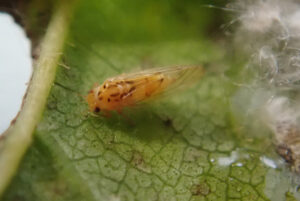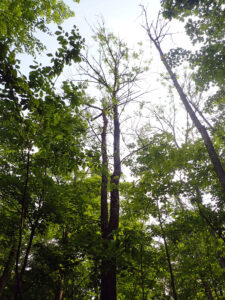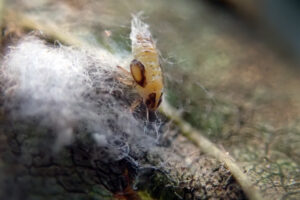
A close-up photo of an adult cottony ash psyllid feeding on an ash leaf. / Photo Credit: Steve Garske, Great Lakes Indian Fish and Wildlife Commission
By Linda Williams, DNR Forest Health Specialist, Woodruff
Linda.Williams@wisconsin.gov or 920-360-0665
As if black ash trees don’t have enough problems with emerald ash borer (EAB), another ash pest recently was found at several locations in northern Wisconsin.
In June, Great Lakes Indian Fish and Wildlife Commission (GLIFWC) staff noticed black ash with leaf curling and puckering, early leaf drop and dieback at one of their Climate Change Program’s long-term phenology study sites.
After working with DNR Forest Health staff to narrow down the possibilities, insect samples were collected and sent to P.J. Liesch, director of the University of Wisconsin-Madison Insect Diagnostic Laboratory, for official identification. He identified them as cottony ash psyllid.

Significant crown decline is shown on this ash tree due to feeding by cottony ash psyllid. / Photo Credit: Steve Garske, Great Lakes Indian Fish and Wildlife Commission
This year, GLIFWC staff members have identified cottony ash psyllid at two sites in Vilas County and two sites in Ashland County. They have observed the pest across the border in the western Upper Peninsula of Michigan as well.
Cottony ash psyllid is non-native and has previously been reported just twice in Wisconsin: first in 2006 in St. Croix County, and again in 2020 in Wood County.
It was first detected in North America in 1921 but hadn’t caused many problems until recently. Since 2000, several communities in Canada have had significant problems with the pests killing black and Manchurian ash in cities; a few North Dakota communities have had problems with them as well.
Some Canadian provinces have observed that psyllid numbers explode during dry periods. Wisconsin just experienced a very dry summer, and this appears to have benefited the insects here as well.
The insects produce two generations per year. They use their piercing, sucking mouthparts to suck the sap from leaves, causing curling and puckering as well as early leaf drop.
Damaged leaves may be severely stunted or so tightly curled that they appear as bumpy tubes. A close look at the undersides of the curled leaves will often reveal nymphs, adults or both, depending on the time of year. The nymphs feed on the lower surfaces of the leaves, where they cover themselves with cottony, waxy material. Adults have an appearance similar to a leafhopper and can jump, which gives them the informal name of “jumping plant lice.”
From a distance, black ash infested with cottony ash psyllids show decline and have branch dieback in a “clumpy” or branch-by-branch pattern, rather than the whole crown declining at the same time. Leaves also may look clumpy as they curl and twist instead of the normal, “flat” foliage that moves with the wind. Cottony ash psyllid feeds on black ash (and closely related ash species such as Manchurian ash); green and white ash are avoided.

Feeding by cottony ash psyllid causes leaves to curl and pucker. / Photo Credit: Steve Garske, Great Lakes Indian Fish and Wildlife Commission
What else is affecting ash?
- Woolly ash aphid or ash leaf curl aphid can also cause leaf curling and puckering, but do not cause branch dieback or tree mortality.
- The ash flower gall mite can cause male ash flowers to curl and grow into odd clumpy balls that remain on the trees for a year or more.
- Ash anthracnose is a leaf disease that can cause rapid loss of leaves in the spring. However, the tree will send out a second set of leaves, and infection usually doesn’t cause dieback or mortality.
- Ash yellows causes a slow decline of the crown of the tree, and trees will often have “witches’ brooms”. Witches’ brooms are a type of epicormic branching (growths that emerge from dormant buds along the trunk and branches of a tree). They indicate significant stress, which can eventually lead to death of the tree.
- And, of course, there’s EAB, which can kill all the state’s native ash trees.
Control options for cottony ash psyllid are still being evaluated. Various studies are under way to identify what will work best, and cities are scrambling to find ways to keep their trees alive.

Cottony ash psyllid nymphs feed on the undersides of leaves, where they produce the white waxy material that gives them their name. / Photo Credit: Steve Garske, Great Lakes Indian Fish and Wildlife Commission
Unfortunately, by the time noticeable damage can be casually observed, the trees may be too stressed or compromised to be able to adequately take up systemic insecticides. Because the nymphs feed on the undersides of the tightly curled leaves, they are somewhat protected from foliar spray application, so it’s important to time sprays for when the adults are out and mating.
